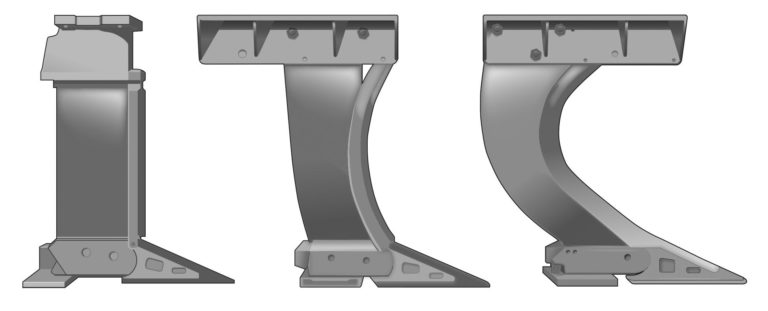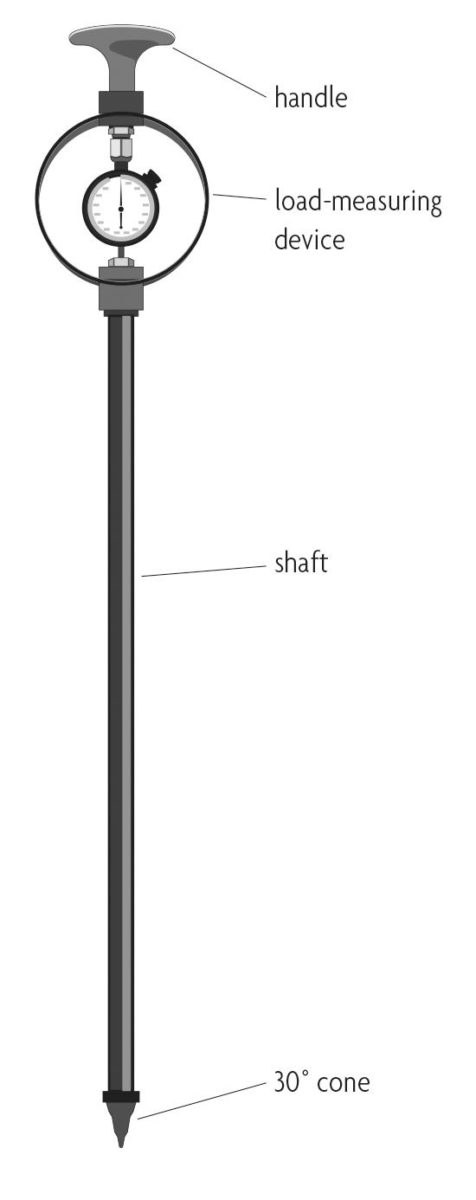Planning budgets for 2011 estimated the total cost of using a four-row subsoiler to be $31.73 per hectare ($12.85 per acre) [16]. A third of this cost, $10.82 per hectare ($4.38 per acre), was for fuel. Wherever in-row subsoiling is needed, reducing the cost emerges as the most likely method of reducing the overall cost of crop management.
Below, four strategies are described to reduce energy consumption during in-row subsoiling. Using all four of the strategies can reduce fuel consumption by more than 50 percent with the actual reduction dependent on your local conditions [19].
Adopt Controlled Traffic
Controlled-traffic systems limit vehicle traffic to certain areas of the field. When in-row subsoiling is used, controlled traffic keeps tractor wheels off the rows. This ensures that future in-row subsoiling events align with previous events and that the shanks will not be required to disturb excessively compacted soils such as occurs under wheel tracks. This minimizes the draft force needed for subsoiling since less energy is needed if the soil has been previously disrupted. When new rows in a controlled-traffic system are located close to rows from previous years, in-row subsoiling has longer-lasting effects. A study of a cotton cropping system evaluated the effect of annual, biennial and triennial in-row subsoiling on soil compaction in an Alabama silt loam over a four-year period. The study found that annual in-row subsoiling reduced bulk density compared to biennial and triennial in-row subsoiling, but there was no significant difference in cotton lint yields [23]. It was determined that a 9 percent reduction in draft force translated to a 6 percent reduction in fuel use [19]. Controlled traffic can reduce severe compaction, making it possible to in-row subsoil less frequently than once per year.
Subsoil When Soil Moisture is Optimum
Soil strength, and therefore the energy needed for subsoiling, varies considerably with moisture content. An extremely dry soil can increase the energy required for subsoiling and therefore increase fuel costs [19]. The effect of moisture content on subsoiling energy and soil disruption was evaluated on a sandy loam in a soil bin at the USDA-ARS National Soil Dynamics Laboratory (NSDL) in Auburn, Ala. [24]. A 28 percent reduction in draft force was noted for a soil at field capacity compared to an extremely dry soil. This means that an estimated 19 percent reduction in fuel use could be obtained by avoiding operating in extremely dry soil [19]. On the other hand, vehicle traffic on extremely wet soils leads to compaction and the need for future deep tillage. Soil moisture conditions will depend upon soil type, weather and climate.
Choose the Right Shanks
The size and shape of shanks used for in-row subsoiling varies. As far back as 1958, the shape of subsoilers has been studied to determine their effectiveness (Figure 6.6) [18]. More recently, several experiments have been conducted in soil bins at the NSDL to determine the most efficient shank for both soil disruption and minimal surface-residue disturbance. Based on soil bin experiments, choosing the right shank can lead to an average reduction in draft force of 32 percent, which translates to a 15 percent fuel savings [19]. For example, a bent-leg shank gauged to disrupt only at the compacted soil depth is efficient at both disrupting the subsoil and minimizing surface residue disturbance.
Reduce Subsoiling Depth
Subsoiling at depths greater than necessary requires significant additional energy and may reduce crop yields while excessively disturbing crop residue on the soil surface. Additionally, loosening the soil deeper than necessary can allow vehicle traffic weight to penetrate deeper into the soil and cause additional compaction. Base the depth of in-row subsoiling on measurements of soil compaction (see the sidebar, Determining the Depth of a Compacted Soil Layer). Southeastern soils are especially variable, and knowledge about the field’s variability allows for shallower or variable subsoiling depths, which will save fuel.
Soil cone penetrometer (Figure 6.7) readings of 290 psi or greater are used to locate the start and end depth of the hardpan (see the sidebar, Determining the Depth of a Compacted Soil Layer). The lower boundary of the hardpan determines the depth of subsoiling. An experiment in southern Alabama over four years evaluated whether tilling just deep enough to eliminate the hardpan layer would reduce tillage draft force requirements and reduce crop yields [22]. The depth of tillage varied from 10 to 18 inches. Corn and cotton crop yields were not reduced, but draft force was reduced by an average of 41 percent compared to deeper subsoiling. This translated into a fuel savings of 14 percent [19].


